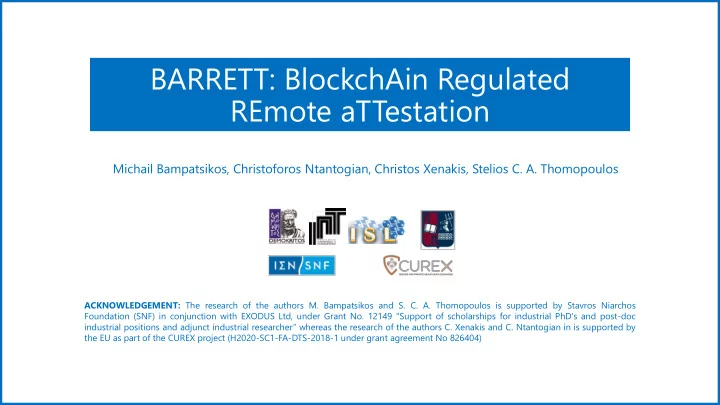

BARRETT: BlockchAin Regulated REmote aTTestation Michail Bampatsikos, Christoforos Ntantogian, Christos Xenakis, Stelios C. A. Thomopoulos ACKNOWLEDGEMENT: The research of the authors M. Bampatsikos and S. C. A. Thomopoulos is supported by Stavros Niarchos Foundation (SNF) in conjunction with EXODUS Ltd, under Grant No. 12149 "Support of scholarships for industrial PhD's and post-doc industrial positions and adjunct industrial researcher” whereas the research of the authors C. Xenakis and C. Ntantogian in is supported by the EU as part of the CUREX project (H2020-SC1-FA-DTS-2018-1 under grant agreement No 826404)
Overview • Problem Statement • BARRETT Architecture • Our proposal • Data flow • Related work • Performance Analysis • Our contribution • Security Analysis • Assumptions and threat model • Conclusions and Future work WI '19, October 14-17, 2019, Thessaloniki, Greece 2
Introduction – Problem Statement • Today an increasing number of IoT healthcare devices connects to the Internet. • They have low computational power; thus limited self-defense capabilities. • One way to protect them is Remote Attestation (RA). • However RA protocols can be used to attack these devices via: a) Computational DoS (CDoS) attacks b) Deliberate Network Congestion • What do we do? WI '19, October 14-17, 2019, Thessaloniki, Greece 3
Our proposal: The BARRETT architecture • Force the verifiers pay a fee for every Attestation Request (AR). • CDoS and network congestion attacks become prohibitively expensive. • The monetary cost deters the verifiers from maliciously using the RA protocol. • The verifiers and provers are members of a Public Ethereum Network (PEN). • Verifiers can send ARs to the provers only as Ethereum transactions. WI '19, October 14-17, 2019, Thessaloniki, Greece 4
Related Work • In their RA design, Defrawy et al. proposed using timestamps to prevent CDoS. • Brasser et al. used nonces to prevent CDoS attacks. • SMARM allows interrupting RA so that the prover can perform its tasks. • TM-Coin is the first RA design to combine an RA protocol with blockchain. • Javaid et al. used Ethereum to counter Distributed Denial of Service (DDoS). WI '19, October 14-17, 2019, Thessaloniki, Greece 5
Our contribution • We use Ethereum’s fees and mining delays to protect the provers. • A smart contract sets a limit to the number of ARs that reach a prover. • Via Ethereum we provide nonrepudiation of actions and an immutable log. • This log enables us to detect dishonest behavior from the verifier. WI '19, October 14-17, 2019, Thessaloniki, Greece 6
BARRETT’s Assumptions and Threat model • Healthcare IoT devices belong to a heterogeneous and dynamic network. • We consider only adversaries that can interact only remotely with the prover. • The adversaries are internal and use the RA protocol to harm the provers. • Adversaries cannot physically interact with the device. • Harming the prover by bypassing the BARRETT architecture is out of scope. WI '19, October 14-17, 2019, Thessaloniki, Greece 7
The BARRETT architecture The BARRETT architecture comprises the following elements: • The PEN which is the main component that protects provers. • The Verification Nodes (VNs) which act as verifiers. • The provers , which are IoT devices and the beneficiaries of BARRETT. • A smart contract that regulates the number of ARs that reach a prover. WI '19, October 14-17, 2019, Thessaloniki, Greece 8
BARRETT – Components’ features Feature Ethereum Ledger Copy Shared Secret Key Mining Submits Account Element transactions Full VN ✓ ✓ ✓ ✓ ✓ Light VN ✓ ✓ ✓ Prover ✓ ✓ ✓ WI '19, October 14-17, 2019, Thessaloniki, Greece 9
Design Decisions • We chose a PEN over consortium or private Ethereum because: a) It offers higher availability and robustness of data. b) Its mining delays are longer. • BARRETT was not designed around an RA type for the following reasons: a) Compatibility with many types of RA. b) Το protect provers in a variety of RA settings. WI '19, October 14-17, 2019, Thessaloniki, Greece 10
BARRETT – Flow of data WI '19, October 14-17, 2019, Thessaloniki, Greece 11
Performance Analysis • The PEN imposes significant storage requirements to the full VNs. • The mining process brings a considerable performance burden to the full VNs. • Provers and VNs must dedicate 928 bits for storing information relevant to their Ethereum account. • The above storage requirement is acceptable even for class-1 IoT devices . • Mining can impose relatively long delays on the RA communication exchange. • These delays may cause problems in RA scenarios that are not delay-tolerant. WI '19, October 14-17, 2019, Thessaloniki, Greece 12
Security Analysis • Through the PEN BARRETT provides: a. Accountability and non-repudiation of actions. b. Data immutability. c. Constant data availability and single point of failure eradication. • Ethereum fees and delays are not enough if ARs arrive from different verifiers. • This is where the smart contract comes. WI '19, October 14-17, 2019, Thessaloniki, Greece 13
Conclusion and Future work Conclusion : • BARRETT is only suitable for RA scenarios that tolerate delays. • In some cases, our architecture may become very expensive for honest VNs. Future work will include: • Expansion of the threat model’s scope. • A methodology that regulates fees for transactions that contain ARs. WI '19, October 14-17, 2019, Thessaloniki, Greece 14
Thank you! WI '19, October 14-17, 2019, Thessaloniki, Greece 15
Recommend
More recommend